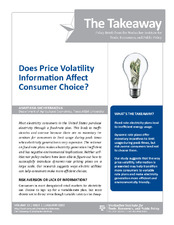| dc.creator | Shcherbakova, Anastasia | |
| dc.date.accessioned | 2022-04-22T22:42:31Z | |
| dc.date.available | 2022-04-22T22:42:31Z | |
| dc.date.issued | 2022-01 | |
| dc.identifier.uri | https://hdl.handle.net/1969.1/195937 | |
| dc.description | Most electricity consumers in the United States purchase electricity through a fixed-rate plan. This leads to inefficiencies and overuse because there are no monetary incentives for consumers to limit usage during peak times when electricity generation is very expensive. The reliance on fixed-rate plans makes electricity generation inefficient and has negative environmental implications. Neither utilities nor policy makers have been able to figure out how to successfully introduce dynamic-rate pricing plans on a large scale. Our research suggests ways electric utilities can help consumers make more efficient choices. | en |
| dc.language.iso | en_US | |
| dc.publisher | Mosbacher Institute for Trade, Economics & Public Policy | |
| dc.relation.ispartofseries | Volume 13;Issue 1 | |
| dc.rights | Attribution-NonCommercial-NoDerivatives 4.0 International | en |
| dc.rights.uri | http://creativecommons.org/licenses/by-nc-nd/4.0/ | |
| dc.subject | electricity pricing | en |
| dc.subject | efficiency | en |
| dc.title | Does Price Volatility Information Affect Consumer Choice? | en |
| dc.type | Article | en |
| dc.contributor.sponsor | Bush School of Government and Public Service | |
| local.department | Other | en |



